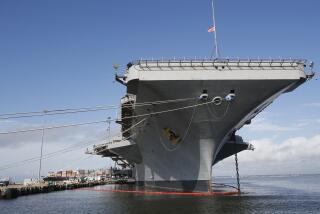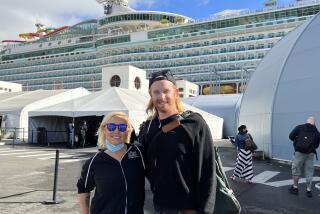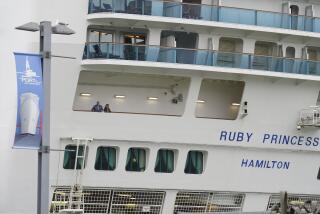Navy took lessons from coronavirus outbreaks on three other ships to act quickly aboard Kidd
- Share via
SAN DIEGO — Novel coronavirus outbreaks aboard three Navy warships have taught the military service valuable lessons that enabled it to respond quickly in late March when a sailor started displaying symptoms of COVID-19 on the guided-missile destroyer Kidd, a vice admiral in charge of the Navy’s surface force said last week.
The Kidd was conducting counter-drug operations in the eastern Pacific near South America when a sailor began showing symptoms of COVID-19, the disease caused by the coronavirus, on April 22. Less than a week later, the ship was moored at Naval Base San Diego, with 243 of its roughly 330 sailors evacuated from the vessel.
Vice Adm. Richard Brown, commander of the Naval Surface Force Pacific in San Diego, said Friday that quick action by the Navy to bring the Kidd into port soon after its first case was reported likely prevented a broader outbreak among the crew.
“This virus is insidious,” Brown said during a conference call with reporters. “If we had left her out there, the entire crew would have got infected.”
Brown said that after outbreaks on other ships — amphibious assault ships Essex and Tripoli, littoral combat ship Coronado and aircraft carrier Theodore Roosevelt — the Navy knew that from the first case on the Kidd, the clock was ticking.
“You can stop the spread of the virus, but it takes a huge effort and urgency to do that,” Brown said.
That lesson came from the Tripoli, a ship recently built in Mississippi. According to Brown, the ship was set to be delivered to the Navy and hundreds of sailors moved aboard in mid-March, just when broad community spread of the coronavirus was picking up nationwide.
The Essex and Coronado, two San Diego ships, were among the first in the Navy to report cases of the coronavirus. Brown said the Essex, while in port, started rotating its crew day to day by duty section — allowing for social distancing onboard. The number of cases initially rose slowly but soon flattened and eventually stopped.
“That almost became the model, but that was the first week of the Navy crisis — when Tripoli hit a month later, we were ready,” Brown said.
When the virus began spreading on the Tripoli, the decision to move crew members off was made within a day of the third confirmed case, Brown said. About 630 sailors were moved off the ship and, as a result, the outbreak was limited to around about a couple dozen sailors.
That number has since gone down, he said.
One of the most valuable lessons the Navy has learned about the virus is how it can spread between people who do not appear ill, known as asymptomatic spread.
The Coronado had its first positive COVID-19 case on March 17. The Navy, for the first time, tested the entire crew — now a standard practice aboard ships leaving for deployment.
“That’s the evolution,” Brown said. “We did not know a lot about the virus back in the middle of March. It’s amazing what we learned. When you do 100% testing, that’s when you find the asymptomatic sailors.”
Asymptomatic carriers of the virus have prolonged the quarantine period for some sailors on the Roosevelt.
The first known coronavirus cases on the Roosevelt emerged in late March. Two days after the Navy announced the outbreak, the San Diego aircraft carrier pulled into Guam. Initially, the Navy said sailors would remain on the ship and be restricted to the pier.
Days later, the ship’s then-commanding officer, Capt. Brett Crozier, sent a letter to Navy captains and three U.S. Pacific Fleet admirals warning that the only way to get the outbreak under control — and save sailors’ lives — was to move 90% of the crew off the ship.
Crozier was fired by acting Navy Secretary Thomas Modly after a copy of that letter was leaked to the media. Modly then resigned less than a week later after a profanity-laden speech he delivered to the Roosevelt’s crew was also leaked.
The ordeal is the subject of an ongoing Navy investigation.
Crozier’s proposal was adopted by Navy leaders and sailors began moving off the ship. Eventually, more than 4,200 who tested negative for the virus were moved to hotels on the island. Those with positive tests were placed in isolation on base.
However, as the Navy began to bring sailors back the ship after at least 14 days in quarantine, some tested positive for the virus, despite having no symptoms.
On Friday, Jonathan Hoffman, a Pentagon spokesman, said the Navy will no longer routinely release specific coronavirus case numbers on ships.
“We believe we’ve moved past the point where the daily updates are providing useful information for public conversation,” Hoffman said.
The last official numbers from the Roosevelt, released Thursday, said 1,102 sailors have active cases of the virus — an increase of 162 from two days prior. The Navy attributed that surge to asymptomatic sailors coming out of quarantine.
In order to return to the Roosevelt, which has been sterilized bow to stern, sailors must now test negative on two successive tests, the Navy says.
That policy will apply to Kidd sailors now in quarantine in San Diego, Brown said. The last numbers released by the Navy said 78 sailors had tested positive — a number Brown said will likely rise or fall over the next couple of weeks.
“Even though a sailor tested negative on the day of arrival, there was crew interaction on the ship,” Brown said, adding that it took about six days for the ship to get to San Diego after its first case. “They might not be at a viral load that they’re showing (right now).”
Brown said he is confident the Navy has learned from what’s happened on the Roosevelt and that those lessons are minimizing the virus’ effect on the Kidd.
“There’s not a massive breakout because we acted so fast,” Brown said.
An industrial cleaning company has been brought aboard to sanitize the Kidd — another lesson from the Tripoli, he added.
The Navy expects the Kidd will remain in San Diego at least a month for quarantine and sanitation.
Dyer writes for the San Diego Union-Tribune
More to Read
Sign up for Essential California
The most important California stories and recommendations in your inbox every morning.
You may occasionally receive promotional content from the Los Angeles Times.










